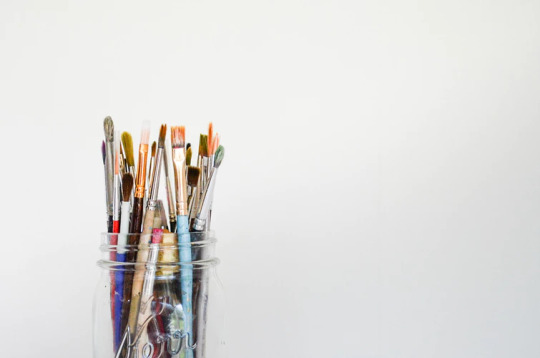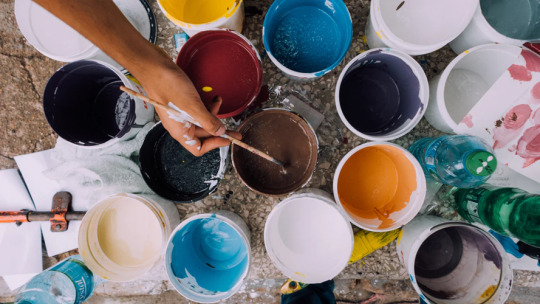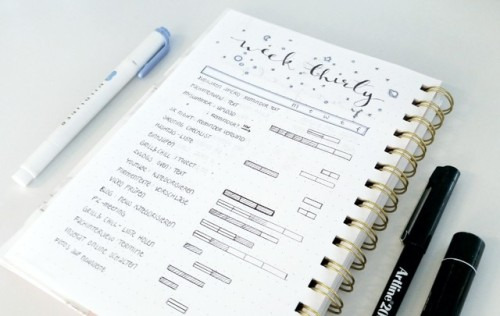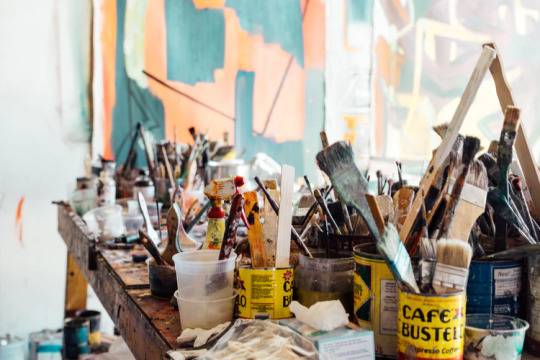Text
Work Hard, Play Hard

I often find it hard to balance work and play, but once you master it, everything will change!
Work
Find artists that you admire. Study, study, study. What tools do they use? What techniques do they use? What inspires you about them? Try to adopt some of their methods and recreate some of your favourite pieces in your own style!
Learn the basics, Youtube is my savior for this! When it comes to lighting, colour theory, composition etc, you need to know your stuff. Take notes and practice what you’ve learned. Once you have the basic knowledge you’ll be set!
Figure studies; there are some great online resources available for free that allow you to draw models posing in real time. Although daunting at first, life drawing is one of the most valuable skills you can gain. Helping train your eye, learn about perspective, angles and beyond.
Reference; Find pictures online. Better yet, draw from life. Directly from primary sources is better, and highly respected. Draw the thing you struggle with the most, over and over. Watch yourself progress. Acknowledge the development.
Play
Any ideas for drawings you might have, get them onto paper. Keep a notebook on your desk, next to your bed, in your bag. You can jot down and sketch your ideas wherever and whenever you are. It doesn’t matter if the idea isn’t complete, or you don’t think you’re explaining it right, just get it down.
Experiment with supplies you’re comfortable with as well as ones you’ve never used before, but have always been tempted to. Make a mess, breathe, have fun, express yourself! Just make marks on the paper and see what happens. Try new things and see what works and what doesn’t.
Just doodle; maybe you don’t have any idea what you want to draw. Just let the drawings take shape. You might start with a scribble or a circle or a line. Let if flow.
Take a look at colour palettes - this is my favourite thing to do. Pair a couple of colours together, add another. What mood does it create? Do the hues remind you of a landscape? Replace a colour, has this changed how you feel about the palette? Markers, paints, magazine pages, I use all sorts to build up my references that often turn in to mood boards for a certain project. Give it a go and run with it!
2 notes
·
View notes
Text
Artist’s Block - 6 Helpful Tips

Have you found yourself stuck for motivation or lacking inspiration? I can relate to this! So I have thought of 6 helpful tips to get you out of your rut and back to art.
1. Recreate
Don’t jump straight in to the deep end! This may work for some, but for me it induces feelings of stress and panic. I say dip your toes in, start slow.
Try picking a few of your favourite images from social media, or choose one of your own. Recreate it in any which way you like! Using paint and inks, ripping up magazines or getting on to Photoshop. This should take away the fear of starting a big new project and help you back in to the creative flow.
2. Challenges
Now you’re back in the swing of things, step it up. Push your boundaries and set yourself a challenge, or take part in one online! This is a great way to get started, once you have a prompt and a reason to get going, you have no excuses.
3. Get up and get out
When it comes to creativity, productivity and inspiration, I suggest going outside and taking in the world around you. Sometimes all you need is a change of scenery. It will be both refreshing and rejuvenating for your brain, plus you’ll have a new backdrop for more drawing opportunities.
4. Love your space
It’s important to make the space you spend the most time in a positive one. It’s okay to spend some time de-cluttering and tidying your desk space to make it just so, even add a few aesthetic extras if you desire - I love my plants, bringing the outside, in. I find working in a personalised space is really relaxing, especially knowing that it caters directly to my needs and everything I use is within reaching distance. Music also helps, so start making that playlist!
5. There’s no pressure
Don’t forget to take your breaks. I’m guilty of forgetting time, when we get so in to a piece of work we tend to forget the concept of time. It’s so important to take a break mentally and physically, make sure to rest those eyes.
Remember, there’s no pressure so don’t force yourself, just start making as and when you feel inspired, once you��re feeling lighter, creativity will flow.
6. Self care
Acknowledge yourself, your talents and your efforts. And appreciate them! The most important thing you can do for yourself is to really recognise each and every victory. Actively talk kindly to yourself, it will really boost your confidence!
Absorb and apply these tips for a healthier relationship with artist’s block! Let me know how you get on.
#tips#all#art#deisgn#illustration#student#budgeting#creative#artists#paint#inspiration#blogger#blogs
5 notes
·
View notes
Text
Sketchbook 101

Your eyes only
Consider your sketchbook as something that’s for you and you only. There is no need to share it with any other person other than yourself, unless you would like to. Knowing this takes the pressure off a bit. It can be a safe space where you can be your authentic self. Eliminate the idea that it has to be pretty or refined or well-put-together and remember that you have control over what parts of it you share and the parts you keep private. So go wild and express yourself.
Make a mess
Go straight in with some blind contour drawings or timed challenges. Become okay with sketchbook work not being perfect or even left incomplete. Write notes and scribble and splash paint, rip and tear. The more you make a mess intentionally, the less the you’ll fear doing it accidentally. And once you’ve eliminated the fear, you enter a whole new realm of creativity.
Designated purpose
Is the thought of ruining a sketchbook with too much variety holding you back from using it as often as you’d like? It might help to have a few sketchbooks on the go at the same time. Designate a specific purpose to each one, maybe one purely for things you’re studying, another for experimentation, and another where you push yourself to create more cohesive and put together spreads.
Preparation
For me, there’s nothing more daunting than blank pages in a brand new sketchbook. To get started, I’ll often prep a few pages with washes of colour or prints to create texture. This makes the whole thing a little scary, for me at least!
Making mistakes
"On the one hand I agree that covering up all your mistakes is gonna limit your progress, you need to look at and analyse the stuff you don’t like in order to be able to use that as a reference point for progress. But on the other hand…. there are sometimes those pages in your sketchbook that you just. cant. stand. To the point that you no longer use the book because that one particular page, just knowing it’s there repels you from even touching the sketchbook. What I’m saying is, in this case (and I give it time, I wouldn’t coverup up a bad page straight away) but I’d rather coverup a page if it’s gonna mean I can happily continue to use the sketchbook, rather than stubbornly leave it, knowing that the sight of it does nothing but knock my confidence and dampen my mood to create. Coverups can give you the chance to try again and they often inadvertently add their own element of interest to a page." - Minnie Small
#sketchbook#tips#tumblr#all#art#deisgn#illustration#student#budgeting#creative#artists#paint#inspiration#blogger#blogs
3 notes
·
View notes
Text
Art Foundation Diploma Supplies List

I’m sure you’re already used to purchasing supplies for your art course on the regular, one of the many joys that comes with being an art student!
After completing my Foundation year in Art & Design, I’m here to share with you what you actually need, the tools you’ll reach for daily compared to the bits and bobs that gather dust in the back of your locker.
At the start of the year I was given a list of supplies to buy before the start of term, half of these I never used and he other half I needed much more of.
Let’s take a look at what universities suggest you start your year with:
A1 black zipped portfolio (without rings)
Several hard backed A3 & A4 sketchbooks
A range of good quality synthetic acrylic paint brushes
1 inch household brush
Readymix poster paint in black, white, Prussian Blue, Burnt Umber, Burnt Sienna, Yellow Ochre, red, yellow and blue
Gouache paints in a range of colours
Charcoal
Compressed Charcoal (black)
A black chinograph pencil
Graphite block
A selection of 3B or softer drawing pencils
One eraser
One Stanley knife
Scalpel
Tool box
Masks
Masking tape
A selection of good quality soft coloured ‘chalky’ pastels or Oil pastels or other good quality wax pastels
One white conte crayon
30cm metal ruler
Spray fixative or cheap hair spay ( just as good for charcoal fixing etc)
A tin of watercolour paints
One A4 size lever arch file
Lined A4 paper for lecture notes etc
Memory Stick
Pritt Stick
PVA Glue
Scissors
Black Drawing Ink
I have put in bold all the items that I used on a daily basis, these were my absolute essentials! Of course this will differ from person to person, for example it’s highly likely you will want to switch the watercolours for some oil paints or even a sewing machine. It’s all dependent on what you specialise in.
I would recommend having a selection of inexpensive art materials (chalks/pastels/inks) for scamps and mock ups as to not waste your more pricey materials, especially during the experimentation phase. Leave the expensive supplies for the development and final creation.
#tumblr#artist#materials#all#art#deisgn#illustration#student#budgeting#creative#artists#paint#inspiration#blogger#blogs
5 notes
·
View notes
Text
An Art Student On A Budget

As artists, we tend to sacrifice a lot for the love of art. Many of these things happen to be priorities, things we need to stay alive!
We battle with the idea of perfection, we swap socialising for extra studio time, we work through the night to reach a deadline and we even spend our money on art supplies over food.
A non-creative may think this sounds extreme, but most artists I know are working towards a greater goal and have learnt to swerve the quick Costa trip - that four brownies and two coffees later has turned in to a three and half hour natter with the girls - and instead save their money for their next art splurge.
We’ve all been there, and as a girl with an insane sweet tooth I know just how tempting that brownie sounds right now, so here is a few quick tips to keep you on track as you’re walking down the high street.
1. Decide what you need
Being a creative, I have discovered I am easily tempted by the aesthetics of a new set of brushes or a box of paints. After looking at my watercolour collection six months ago, half of them were still unopened, the other half only partly used. This is when I asked myself, did I really need to buy all of these?
The key here is to assess what you need, not want. Think of the project(s) you are currently working on and focus solely on the media these require.
2. Make a list
Plan your art shops. Make a list of what you need, and don’t stray from it! While wondering the high street it’s easy to get pulled from isle to isle and end up with a basket full of gifts for yourself. Find your focus and remain disciplined. Going shopping can be great for bargain hunting and comparing prices, just ensure you’re sticking to your plan.
If this doesn’t sound like you, try online shopping!
3. Buy in bulk
Personally, I find it easiest to head online to purchase my goods. You are less likely to get distracted by other items if you only search directly for what you need. It is also profoundly cheaper to buy in bulk! I do this with items I get through quickly, like watercolour paper or white paint. This makes such a difference, and means you don’t have to pop to the shops too frequently either!
#budget#tumblr#all#art#deisgn#illustration#student#budgeting#creative#artists#paint#inspiration#blogger#blogs
70 notes
·
View notes
Text
Sketchbook Tips

1. Look around you
Always have your eyes open to potential inspirational, whether it’s a normal working week or you’re travelling, there’s always objects of interest about. You might just have to step outside the comfort of your bedroom and go for a walk, or open the window and stick your head out!
2. Collect everything
I’m a hoarder when it comes to tickets and leaflets. Anything that is a reminder of a good day or sparks a happy memory! I usually use these as a center piece on my sketchbook pages, I like to stick them in and work from them.
3. Write as much as you like
Now this one is dependent on the type of sketchbook you’re keeping. It may be purely visual, or you might journal to keep track of what the day holds and how you’re feeling! Both are great options and it’s a personal choice. I find writing is a great way to fill up an awkward empty space, but only if it’s relevant to the subject. Always try to include the date to keep track, this makes it easier in years to come when you’re reflecting on old work and checking up on your progress.
4. Use photos
I’m not only a collector of tickets, but photos! I love keeping polaroids and prints of pictures. A healthy mix of landscapes, portraits, and fun, candid photos work so well to tell a story without any words! Just add a few quick sketches of relevant images (or doodle on top of the photos) and you’re good to go!
5. Choose your tools
The biggest thing to think about is what type of sketchbook you want to use, and this is all down to what media you’ll be using on the paper. As long as the quality is good enough for what you want, you don’t need to go overboard with the price. At the end of the day, your sketchbook is what you make it!
#tumblr#all#sketchbook#tips#art#deisgn#illustration#student#budgeting#creative#artists#paint#inspiration#blogger#blogs
261 notes
·
View notes